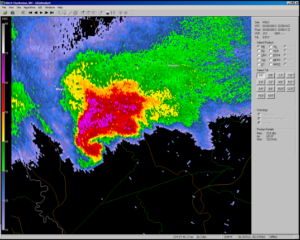A weather radar consists of a transmitter and a receiver. The transmitter emits pulses of radio waves outward in a circular pattern. Precipitation scatters these radio waves.
“Reflectivity” is the amount of transmitted power returned to the radar and measured by its receiver. The intensity of this received signal indicates the intensity of the precipitation.
Measuring the time it takes for the radio wave to leave the radar and return tells us how far away the storm is. The direction the radar is pointing locates the storm.
A hook echo is a pattern in a reflectivity image. It looks like a spiral turning outward in a clockwise way, with the “thickness” of the precipitation increasing — or, a hook shape. This pattern suggests the storm is rotating and may produce a tornado. A tornado might be found at the spiral’s narrow apex.
Doppler radars measure how fast the particles in the cloud are moving toward or away from the radar. The returning radio waves have a higher frequency if the cloud particles are moving toward the radar, and a lower frequency if particles are moving away. This allows Doppler radars to identify severe weather. For example, a spinning vortex would have particles switch from moving toward and then away from the Doppler radar over a small distance.
A radio wave is an electromagnetic wave and therefore has electric and magnetic fields that are oriented perpendicular to one another. This is referred to as polarization. Dual polarized radars measure this polarization and can discern between heavy rain, hail, snow and sleet, as well as debris from a tornado.
When a tornado is on the ground, it lofts dirt, plant matter and other debris into the atmosphere. Because radar is designed to detect the presence of airborne objects, it can show meteorologists where debris is present and thus the tornado.
Steve Ackerman and Jonathan Martin, professors in the UW-Madison department of atmospheric and oceanic sciences, are guests on WHA radio (970 AM) at 11:45 a.m. the last Monday of each month. Send them your questions at stevea@ssec.wisc.edu or jemarti1@wisc.edu.


